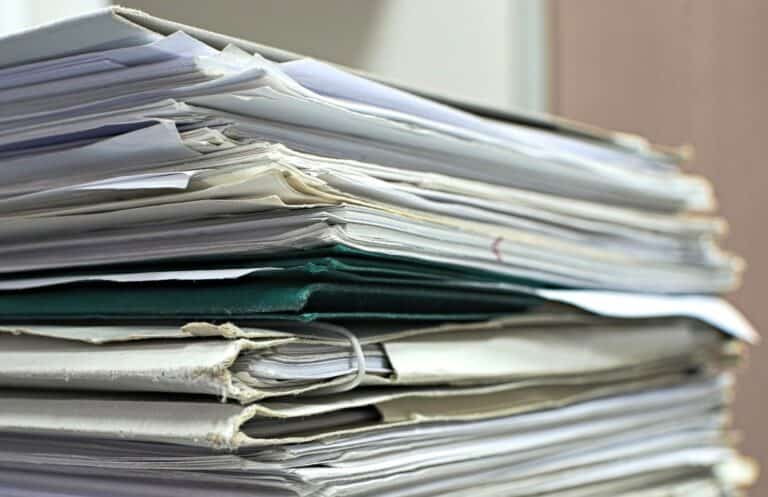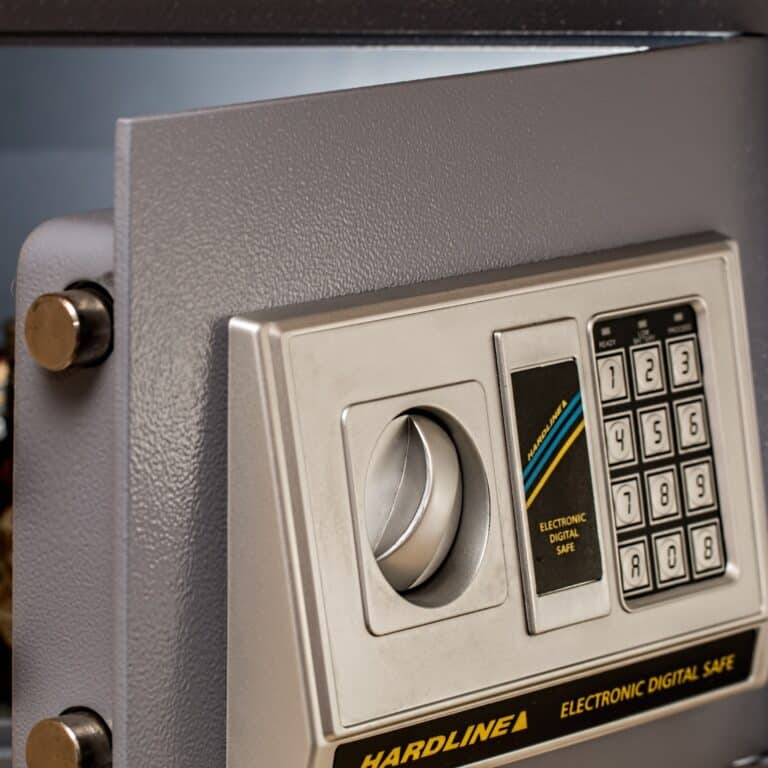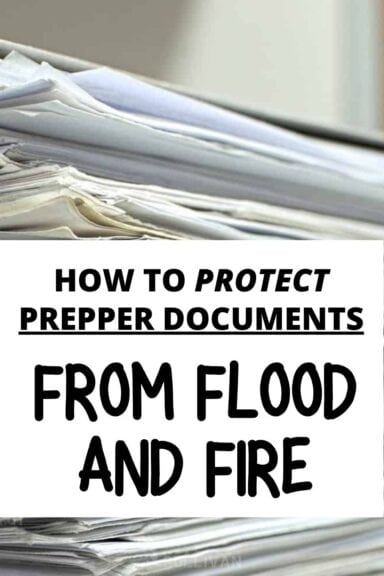Statistically, two of the most likely disasters that you’ll encounter are floods and fires. Both are devastating, potentially deadly, and very likely to drive you from your home.

Whether it’s severe localized flooding, regional flooding from severe weather, a house fire, or a wildfire that is threatening to wipe your town off the map, you’ve got to be ready.
Part of that is being prepared with a plan and a bug-out route. The other part is protecting your critical documents: paperwork that proves your identity, proves what you own, and what policies you have when it comes to insurance and end-of-life decisions…
If these documents get destroyed or become inaccessible in the aftermath of a disaster, you’ll be facing a different kind of nightmare. We might not be able to prevent a fire or flood from taking place, but we can stop them from destroying our critical prepper docs.
In this article, I’ll walk you through protecting those docs step by step and give you some other considerations to help you get ready.
Societal Life Goes On During and After a Crisis
In my experience, preppers have a sort of blind spot for what I call administrative preparation. Everybody wants to buy equipment, supplies, and put together plans for evacuating in the nick of time, but nobody wants to deal with the boring stuff like this!
I understand it, believe me, but you should also believe me when I tell you that life will go on during and after a crisis. Once the immediate danger has passed, you’ve still got to prove your identity to authorities, institutions, and other providers that can help you.
Eventually, we pray, things will get back to normal, and when that happens, you’ll be dealing with bills and bill collectors, insurance agents, banks, county clerks and registrars, and all the rest.
As horrible as things might be if you lose your home or it’s severely damaged, it’ll be so much worse if now you are facing a stonewall of bureaucracy because you’ve lost these critical items!
Because of that, you’ve got to plan for the aftermath, so take what I’m going to tell you seriously…
What Kinds of Prepper Docs Should You Protect?
There are lots of personal documents, IDs, and more that are worth protecting. Ready.gov has published a thorough and useful list, but a partial list is below. Basically, anything that you think you should have on hand in the aftermath of a crisis, you need to include in your protection plan!
- Birth Certificates
- Marriage Certificates
- Divorce Certificates
- Child Custody Papers
- Social Security Cards
- Military Service Records
- Passports
- Driver’s Licenses
- Mortgages
- Leases
- Deeds
- Vehicle Titles and Registrations
- Bank Records
- Insurance Policies
- Tax Statements
- Estate Planning Paperwork
- Comprehensive Family, Service Provider, and Emergency Contact Info
Consider those docs the absolute basics. There’s a whole lot more that may or may not apply to you, your family, and your life!
In the following sections, we’ll talk about actually protecting these docs, either as originals or duplicates.
Keeping Your Docs Safe Against Flooding
Water is immensely destructive and can dissolve paper, make it too weak to even touch, or just bleach the ink out of it, rendering it illegible.
The following are action items to protect your prepper docs from flood and other water-related events specifically:
Don’t Store on the First Floor or in the Basement
It’s common to keep important documents in a secluded, out-of-the-way place so they don’t get lost in the shuffle of everyday life. However, you’ll be making a big mistake if you keep them in the basement or on the first floor of your home, assuming either is in any way vulnerable to flooding.
Water always follows the path of least resistance, and rising water will encounter the lower parts of your home first, damaging or destroying everything in it.
If you can keep your documents on the second floor of your home, or potentially even in your attic, they will be safe from the worst ravages of flooding unless it is truly biblical.
If you don’t have a second story, consider storing your documents up on a high shelf to hopefully keep them out of rising water.
Put Docs in a Waterproof Container
This step should be obvious, I hope! Storing these critical life documents in a truly waterproof container will give them a high degree of protection from water, flood water, or otherwise.
This can be something as simple as a heavy-duty Ziploc bag or as intricate and specialized as a fully submersible, gasketed waterproof equipment case.
Obviously, the more expensive and specialized the solution, the better protection you’ll have, especially if your docs are submerged for any length of time.
Some containers are waterproof against splashing or immersion in shallow water—for a time! Only the best are truly waterproof even if submerged under many feet of water for an extended duration.
Laminate for Maximum Protection
If you really want to protect your documents from water, consider having them laminated if you can.
Lamination, done properly, completely encapsulates the paper in a wraparound envelope of plastic. This means that even if the water reaches your docs where you have them stored, even if the waterproof case fails, the docs themselves will have an additional layer of protection.
However, this can be expensive and time-consuming to do depending on how much you have to protect.
Furthermore, many official identity documents like social security cards, birth certificates, and the like specifically should not be laminated according to government mandates or recommendations.

Protecting Docs Against Fire
All kinds of paper, obviously, are incredibly vulnerable to fire. Your docs don’t have to catch fire directly to burn up, as intense heat is capable of scorching and curling the paper into uselessness and illegibility.
Even exposure to smoke can discolor them enough so they can’t be read or won’t be accepted by authorities.
Keeping your papers safe against fire invariably requires specialized equipment solutions, but you can minimize the risk of fire damage with careful selection of storage location, too.
Disclosure: This post has links to 3rd party websites, so I may get a commission if you buy through those links. Survival Sullivan is a participant in the Amazon Services LLC Associates Program. As an Amazon Associate, I earn from qualifying purchases. See my full disclosure for more.
Use a Fire-rated Safe or Filing Cabinet
The very best, and nearly only, method for keeping your documents safe from fire is the use of a fire-rated safe or filing cabinet.
Some are small and portable like a briefcase, others are huge and heavy like modern gun safes.
All use a mix of fire-resistant materials that won’t ignite and, usually, heat-reactive foam or agents that will seal up cracks and prevent fire and smoke from reaching the items within.
Nominally, these containers will prevent paper from burning up. But there’s a catch…
If the safe is exposed to fire directly or kept in a blazing hot environment long enough, the air temperature inside the unit can get hot enough that the paper can automatically ignite, or just char beyond recognition.
Nonetheless, you’ve got to have one. Some are even advertised as completely watertight in addition to being fire resistant; that can do double duty on flood defense, too!
Store Docs Away from Flammable Materials
A fire won’t necessarily destroy your whole house and everything in it. You might be dealing with damage or just a partial loss. If this happens, you’ll be in luck if your docs aren’t near the source of the fire.
Because of this factor, you are wise to store them away from flammable materials and away from likely sources of fire in the home. Don’t keep them near the kitchen, and keep them away from bookcases, furniture, drapes, and any place where you typically burn a candle.
The farther away they are from these literal hot spots, the more likely they are to survive a smaller fire.
Keep Docs Portable and Ready to Grab if You Can
You are smart to keep your papers in a portable and ready-to-go format, meaning easy to grab on your way out the door when you are evacuating.
If you keep them in a small fire safe that’s also watertight, you can grab them right alongside your bug-out bag and other critical supplies.
If you keep them inside a large safe with a manual dial lock, you’ll have time enough to procure them if you know flood waters are rising or a wildfire is approaching, but not in the case of a surprise house fire.
You need to strike a balance between security, protection, and portability. Think this through carefully and implement according to your situation and plan.
Consider Keeping Critical Docs in a Safe Deposit Box
On the other hand, your best bet for all-around protection might be keeping your documents in a safe deposit box.
Bank buildings tend to be fairly sturdy, especially the larger ones, and even then the vault or secured deposit area will be ruggedly reinforced and proof against all but the most calamitous disasters.
The trade-off, of course, is that you cannot access your documents quickly when you need them…
Plus, if the bank itself is destroyed or put out of action, it’’ll be some time before the institution can get its act together enough to start verifying identities and giving depositors and customers access to their money and deposit boxes again.
Nonetheless, these deposit boxes provide a level of assurance that is difficult to obtain in most residential settings.
Always Make Backup Copies!
Regardless of your security disposition, I urge you to make backup copies of every single important document you have.
These can be photocopies, or you can just take pictures using your smartphone. Either way, make sure they are clear and legible.
Depending on what you need them for, and who you’re talking to, photocopies either will or will not suffice.
But, you’ll find that most places won’t give you a hard time if you’re dealing with the aftermath of a disaster that displaces you and potentially destroys your home and other possessions.
Protect hard copies as you would the originals. If you took pictures or scanned them, see the next section.
Should You Digitally Store Important Docs?
A big point of contention among some folks in the prepping community right now is whether or not you should digitally store scans or pictures of your critical personal documents.
Like almost everything else when it comes to preparedness, there is no true right answer: instead, there are only trade-offs.
The great thing about digital copies is that, depending on the storage location, they are instantly accessible and readable on nearly any computer or other device.
If you keep your docs on Google Drive or in some other cloud-based service, you don’t even need your original device to access them as long as you have your login credentials. This is the very height of convenience and easy access.
But the downside is that cloud-based storage really just means stored on someone else’s computer or server. Data breaches, hacking, spyware, and the straight-up sale of your user data or files could give unauthorized persons every single thing they need to steal your identity.
An alternative is to keep digital copies of your files on a flash drive and then encrypt them.
Kept among your other survival goodies in a bug-out bag or go bag, you could then open them up on a computer of your choosing with more control over their dissemination.
Of course, that won’t help you if the flash drive gets stolen or goes missing. Both approaches have merit; it’s up to you to do your due diligence and minimize the vulnerabilities of either.

The post Protecting Prepper Documents from Flood and Fire appeared first on Survival Sullivan.
By: Tom Marlowe
Title: Protecting Prepper Documents from Flood and Fire
Sourced From: www.survivalsullivan.com/protect-documents-from-flood-and-fire/
Published Date: Tue, 30 Jul 2024 15:29:38 +0000
------------------------
Did you miss our previous article...
https://bushcrafttips.com/bushcraft-news/ferro-rods
 What is BushcraftSurvival SkillsToolsVideosBushcraft CampsBushcraft KitsBushcraft ProjectsPrivacy PolicyTerms And Conditions
What is BushcraftSurvival SkillsToolsVideosBushcraft CampsBushcraft KitsBushcraft ProjectsPrivacy PolicyTerms And Conditions
